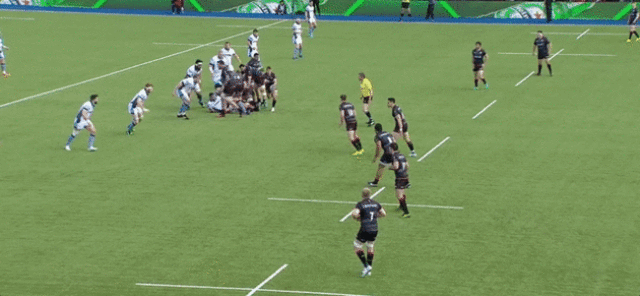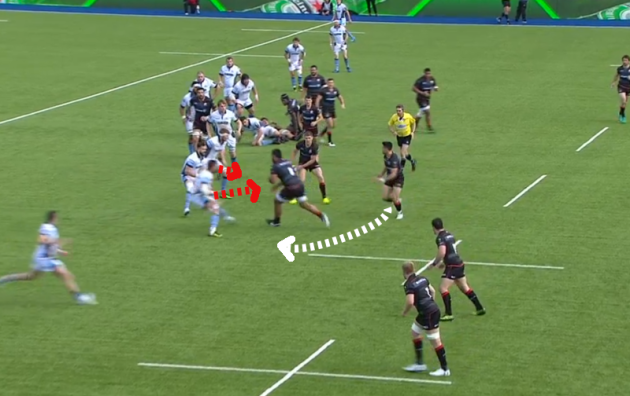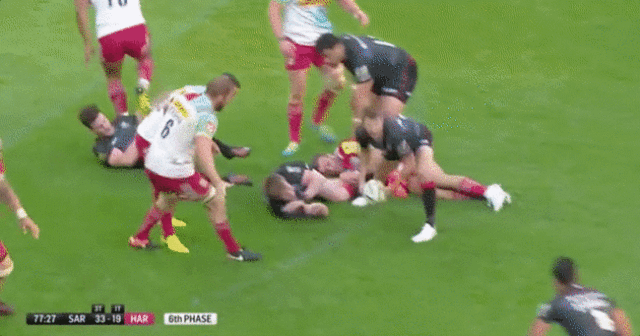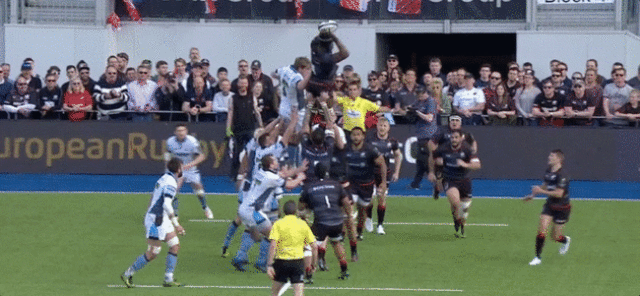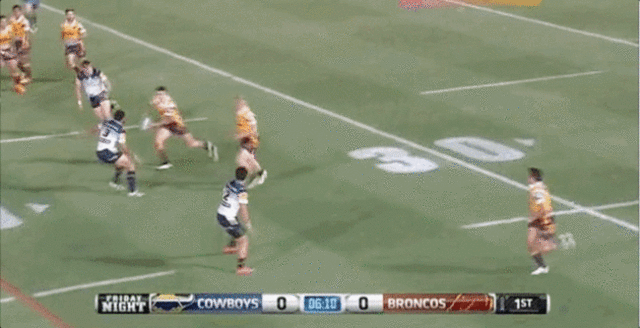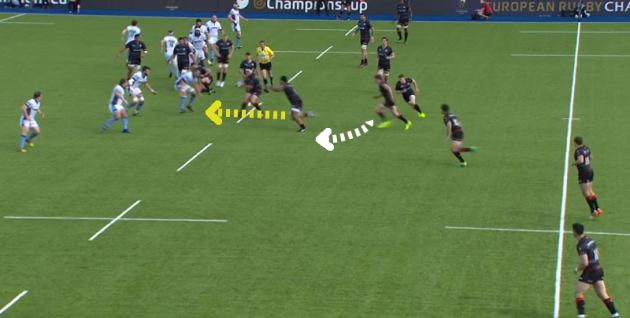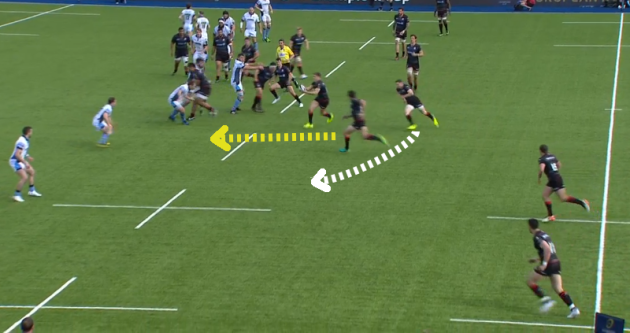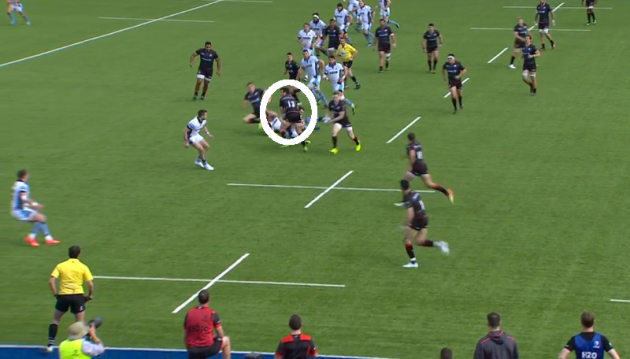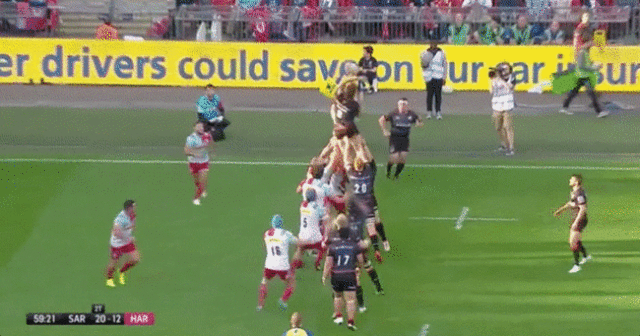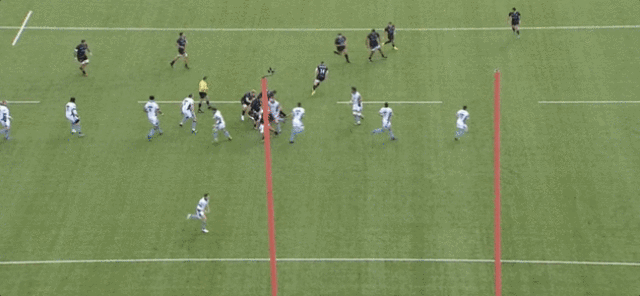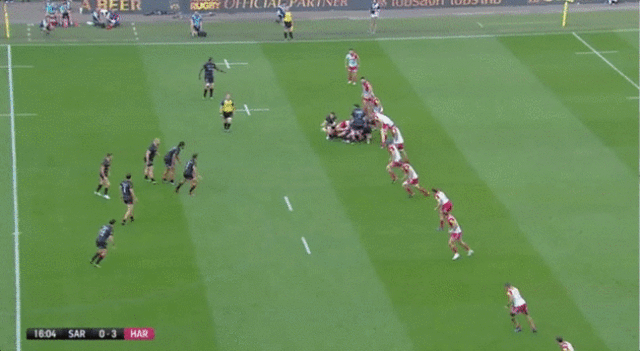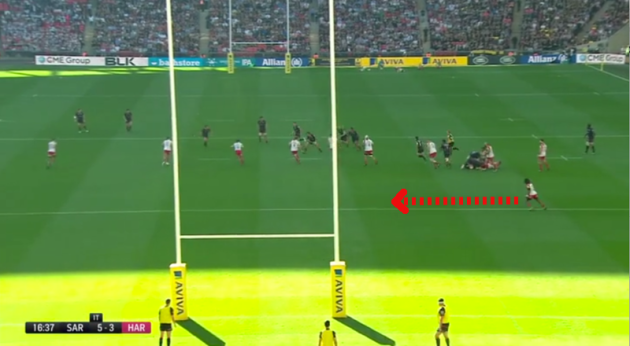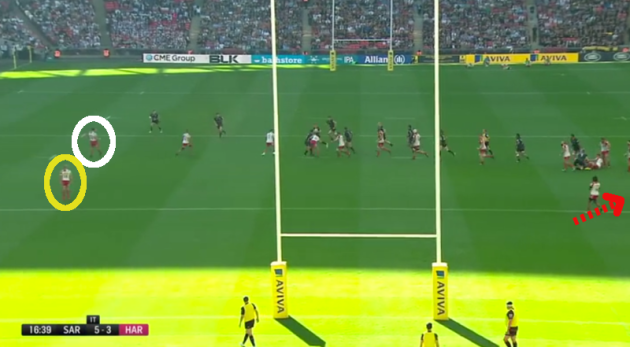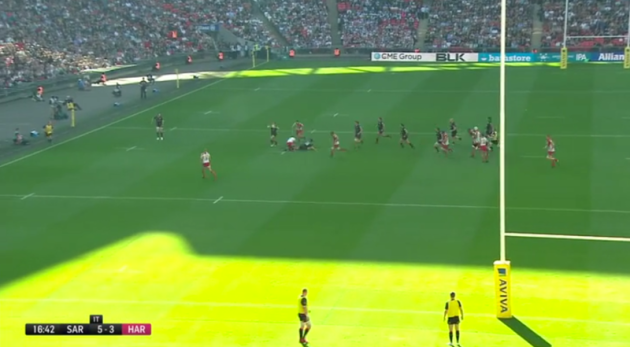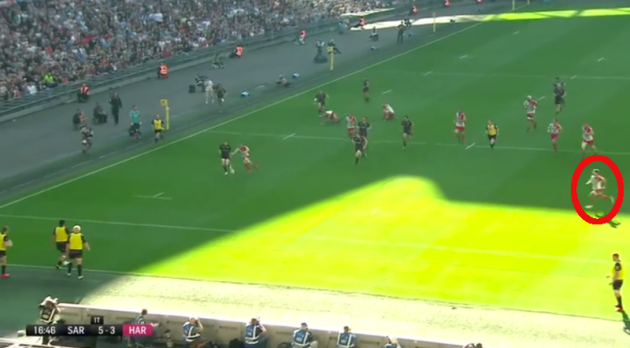Updated 9pm
WHILE OLD STEREOTYPES about Saracens seem to live on, the Premiership side are more than capable of playing exciting, effective and clinical attacking rugby with ball in hand.
They have a number of excellent ball carriers who allow them to play with directness, but the last few years have seen them become a team that is comfortable offloading and using their passing game to break defences down.
We know Saracens’ kicking game is superb in terms of gaining ground and pressuring the opposition, but their use of the boot also extends to bringing another string to their attacking bow.
Munster will need to be very wary of the rugby league traits in Saracens’ attack tomorrow at the Aviva Stadium, as they look to upset the odds and beat the reigning European champions.
Screen passes
The most distinctive feature of Saracens’ attacking play is the quality of their screen passes, which originated in rugby league before being adopted in union. They are extremely common in union now, but few sides use this kind of pass as well as Saracens.
What is a screen pass? We see one below, as Owen Farrell pulls the pass behind the the ‘screening’ Billy Vunipola to Sean Maitland, who makes the linebreak.
It’s a very simple play, but it’s quite clear how effective it can be.
The hard, flat run of Vunipola attracts two defenders [red below] – with Glasgow’s Ryan Wilson biting in from the outside to leave space for Maitland [white] to burst into.
The delay on out-half Farrell’s pass – a dummy pump of his arms as if to pass – is important as it invites Wilson to bite in on Vunipola, who is obviously a big threat if he gets the ball.
Farrell, in his preferred 10 shirt, is central to Saracens’ use of the screen pass, which should be no surprise given that his first rugby experiences as a youngster were in league and the fact that his father is all-time league legend Andy Farrell.
“I guess [Owen] Farrell probably learned this from his dad, his dad was a rugby league master,” said Munster boss Rassie Erasmus of Saracens’ use of screen plays.
They do it perfectly, probably the best, especially off third or fourth phase when it looks unstructured and they seem to find structure in chaos.
“We must try and find defensive structure when they’re doing those things. Of course, if you try to figure out what mini-move they’re doing, they have so many different options and they always seem to pick the right one. Those will be the kind of things we will try to contain.”
Front door
Saracens’ excellent decision-making means that it’s constantly difficult to defend them in these instances, particularly when it happens in phase play, when they can target slower-reacting forwards in the defensive line.
Above, we see Saracens use their screen-pass set-up to score on seventh phase against Harlequins, but this time Farrell actually goes to the ‘screen’ player with his pass. Herein lies a key point: there are always options on this play.
The player in possession can carry himself – indeed, he must challenge the first defender as much as he can. Alternatively, he can pull a pass back to the ‘second wave’ player, or simply slip a short pass to the ‘screen’ player running on that hard, flat line.
Farrell goes for the third option in this instance, getting his option from the opposition.
Harlequins’ defensive shape is disastrous and – as is their wont – Saracens take advantage perfectly.
Farrell gets to the outside of a second row, inviting the Harlequins prop to bite in on him [red arrow].
Just in behind, the other Harlequins lock is in no man’s land [circled in white], offering nothing to the defensive line as Saracens attack rapidly.
With the Quins prop biting in, wing Marland Yarde [circled in red] is left with a big decision to make. Does he bite in on Saracens screen Michael Rhodes [running the yellow line] or does he worry about the second wave Alex Goode [white line]?
Knowing how frequently Saracens throw that pull-back pass in their screen set-up, Yarde opts to shoot up towards Goode, but Farrell is too intelligent and slips Rhodes away.
Damagingly, Yarde does not manage to slow Goode at all and the Saracens fullback is rewarded for his superb trail run – they are excellent here too – as Rhodes draws the final man and releases the fullback to score.
Playmakers
It’s important to highlight that it’s not always Farrell at first receiver on these screen plays and it’s not just the out-half who is capable of making good decisions on the ball.
Above, it’s Billy Vunipola who gets on the ball and makes a fine decision. He has Farrell hovering out the back door as the second wave attacker, but instead slips a clever short pass to flanker Jackson Wray to break through the Glasgow defence.
Vunipola consistently makes good decisions like this on the ball, while his brother Mako and a host of other Saracens players excel here too. Munster simply cannot switch off for a second tomorrow.
As Erasmus has said, they southern province must “find defensive structure” through multi-phase defence, ensuring they do not get lazy or fatigued and slip into the kind of disorganisation Harlequins showed.
There will be a huge demand on players to fill the defensive line, then make good individual reads around which Saracens attacking player to target. Doubling up on a single attacker can be catastrophic.
Set-piece screens
While Munster will need to be prepared for the screen passes in phase play, Saracens also use these shapes clinically off set-piece attack.
Above, we see a stunning two-phase attack against Glasgow that saw Maitland just failing to score in the corner, but it shows the clear threat of Saracens and their screen passing.
Brad Barritt carries directly on first phase and then Saracens attack around the corner, using two screen passes in a row to create the gap for Goode to run into. Again, this is totally familiar to rugby league fans.
The example below, from the NRL’s Broncos, sees them cut the Cowboys apart in almost identical fashion.
Saracens are supremely organised in this attacking play and then the decisions they make on the ball are excellent. On top of that, every player off the ball does their job superbly.
Barritt carries off Farrell from lineout ball off the top, getting Saracens over the gainline and immediately pressuring the Glasgow defence.
As they come around the corner, we must note the positioning of Chris Ashton [circled below], as he will be vital to the attack.
Ashton initially runs the second wave line to offer an option for Farrell to pull the ball behind Barritt. But, as planned, Farrell hits Barritt on the flat, hard line to carry.
Ashton briefly thinks about hitting the breakdown, but realising that forwards are arriving from the back of the lineout to do so, he turns and heads back into the attacking line to play a key role.
In the meantime, hooker Jamie George and Billy Vunipola have arced all the way around from the front of the lineout to get around the corner.
George, entirely comfortable on the ball, takes it to the line threateningly, while Vunipola runs a really good screen line to his outside [yellow above], getting his hands up and calling for the ball – what some coaches call ‘animation’ – in order to attract defenders.
At the last split second, George pulls his pass back to Farrell [white line] who has run in behind Vunipola.
Already, there is strain on the Glasgow defence but Saracens are still behind the gainline, having pulled their pass backwards.
Unfortunately for the Warriors, Ashton has worked hard back into position and Saracens have another screen set-up ready to strike.
Farrell is on the ball, while Marcelo Bosch [yellow] acts as the screen and Ashton [white] provides the second wave.
Of course, as we know, Bosch himself is a threat if Farrell passes to him coming on that hard, flat line and Glasgow outside centre Nick Grigg can’t resist biting down on the Saracens 13 [as circled below].
Bosch’s line is really clever as he makes sure he gets to Grigg’s outside shoulder, therefore meaning that even if Grigg didn’t engage in tackling him, it would be very hard for the Glasgow centre to get beyond Bosch to Ashton.
Grigg throws his arms up in frustration afterwards, trying to suggest to the referee that he’s been illegally taken out, but it’s done superbly by Bosch to make sure he’s not penalised.
The fluidity and execution from Saracens means they end up with a three-on-two on the outside edge, allowing Ashton to straighten to Tommy Seymour’s inside shoulder and slip Goode into the gap, before the fullback draws backfield cover Henry Pyrgos and feeds Maitland on the outside.
Glasgow do just about rescue the situation, but it’s a prime example of the threat from Saracens with their screen passes off set-piece.
In the clip below, we see Saracens run a very similar play, only this time on first phase.
In this case, Ashton probably would have been best served by actually holding the ball and running hard at the outside shoulder of Harlequins 13 Joe Marchant, who almost bites down on the second screen player before recovering his feet.
Harlequins drift hard and manage the situation as fullback Mike Brown comes forward to join the defensive line on the outside edge, before Marchant gets across to complete the tackle.
In the clip below, the reverse angle of the attack against Glasgow gives us a sense of just how difficult it can be to defend this kind of play from Saracens.
From Munster’s point of view, the heartening thing is that they have been brilliant in defence this season, with Jacques Nienaber making a big impact in that department and the players wholly buying into his philosophy and mindset.
Nienaber has backed the players to make reads and shoot up hard in defence, shutting the ball down before it can be passed further out the attacking line.
In instances like these against Saracens, that is very likely to be the formula.
Of course, there is risk in that if the ‘screen’ player is not marked up on, therefore allowing Saracens to slip through the front door, but we should expect Munster to sprint up aggressively and look to smash the second-wave attackers ‘ball and all’.
Grubbers
Munster’s likely intention to fill the defensive line – therefore allowing them to go forward with aggressive linespeed – means they will need to be even more aware of another rugby league-esque Saracens strength.
Mark McCall’s men are expert proponents of the attacking grubber kick. They use grubbers as a means to pressure the opposition into poor exiting kicks, giving Saracens the kind of attacking lineout they thrive from, but it’s also a try-scoring weapon.
Again, those who watch rugby league will be aware that teams in the 13-man code are generally superb at grubber kicking to score, particularly when they get to their final or second-to-final possession.
Union is probably slightly behind league in this skill, but the New Zealand sides and Saracens are among the very best.
The clip above shows us a fine grubber from fullback Goode – he is brilliant in this area – but it also provides us with an example of another variation on the screen set-up that Saracens regularly use.
Hooker Schalk Brits hits the ‘screen’ player, Brad Barritt, but then Barritt drops the ball backwards to Farrell rather than carrying, creating something of an L shape with the string of passes.
It’s something Saracens use often – Ireland used something similar during this year’s Six Nations – and Munster will need to be tuned in to this variation.
There’s a lovely offload from Duncan Taylor in this attack, but we’re most interested in the kick from Goode and how Harlequins are set up to deal with it.
The man to keep an eye on initially is Yarde, who is swinging across from right to left in behind the Quins defensive line.
This is very basic movement in the backfield from the blindside wing, as Harlequins’ ‘pendulum’ swings into life.
The ‘pendulum’ refers to the movement of a defensive team’s backfield. When the opposition attack wide, that will often mean the openside wing moves up into the defensive frontline.
In turn, that will often mean the fullback swings up towards the outside edge to cover that space if the attacking side shifts the ball there.
And in turn, that means the blindside wing must swing across to cover the kick space in behind the fullback or tackle the final attacker on the outside edge.
We can see above that Quins left wing Tim Visser [white] is up in the front line, while fullback Mike Brown [yellow] is in position to swing up into the line and cover the wide attack.
However, having initially moved across to the left as part of that pendulum, Yarde seems to think Saracens will carry in midfield and reverses his run back to the right.
Now, this may be a system demand in the Quins defence, but it makes little sense given the kicking threat they know Saracens pose.
By the time Saracens get the ball into the situation above, it’s already too late for Quins.
There’s initially a two-on-one scenario before the scrambling Quins defence gets to Goode, but that’s only after Brown has been drawn up by the running threat and Goode has released a brilliantly-balanced grubber into the space that should be covered.
Brown will feel he could have done better coming back to the ball but it’s a nightmare situation as Ashton turns on the pace to chase hard – Saracens excel at kick chase too – and the Quins fullback spills.
We can see above that scrum-half Danny Care has worked across from wide on the right in a vain attempt to help Brown out, but it’s too little, too late after Yarde opted against continuing his initial movement as part of the pendulum.
There is a warning for Munster here, of course, although their work in the backfield has generally been excellent this season.
Indeed, Munster’s defensive performances this season have been exemplary – no one has conceded fewer than their five tries – and it will be a source of confidence ahead of tomorrow’s Champions Cup semi-final.
Saracens pose a very rounded threat to the Munster defence and their rugby league-esque attacking traits will demand incredible amounts of concentration, decision-making quality, physical aggression and communication for the entire contest.
The42 is on Instagram! Tap the button below on your phone to follow us!

